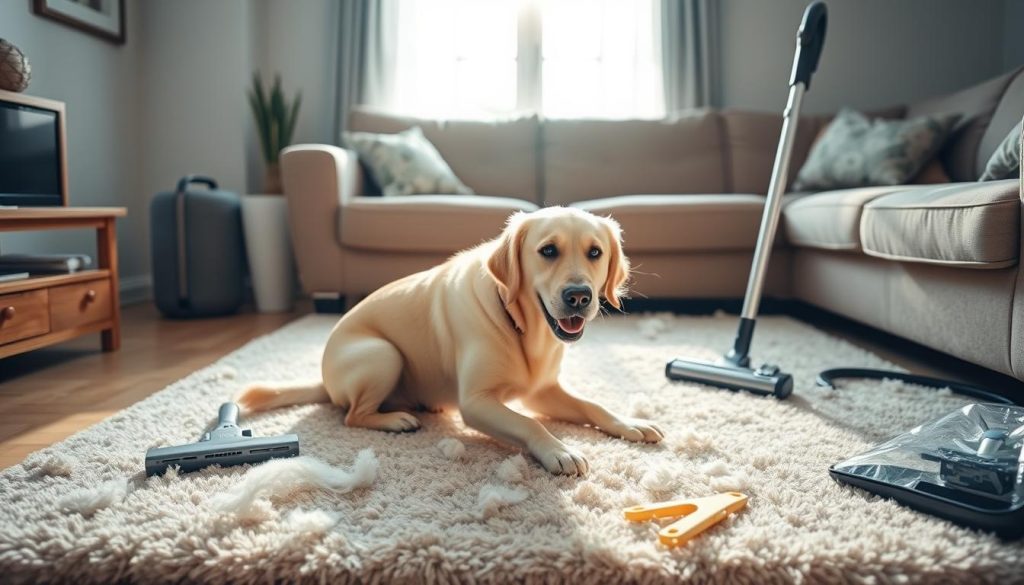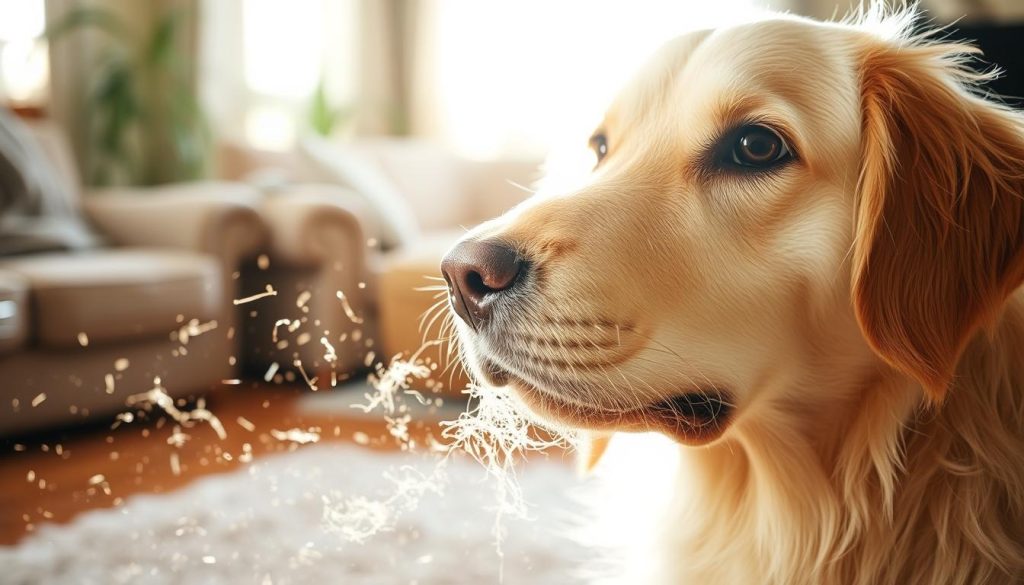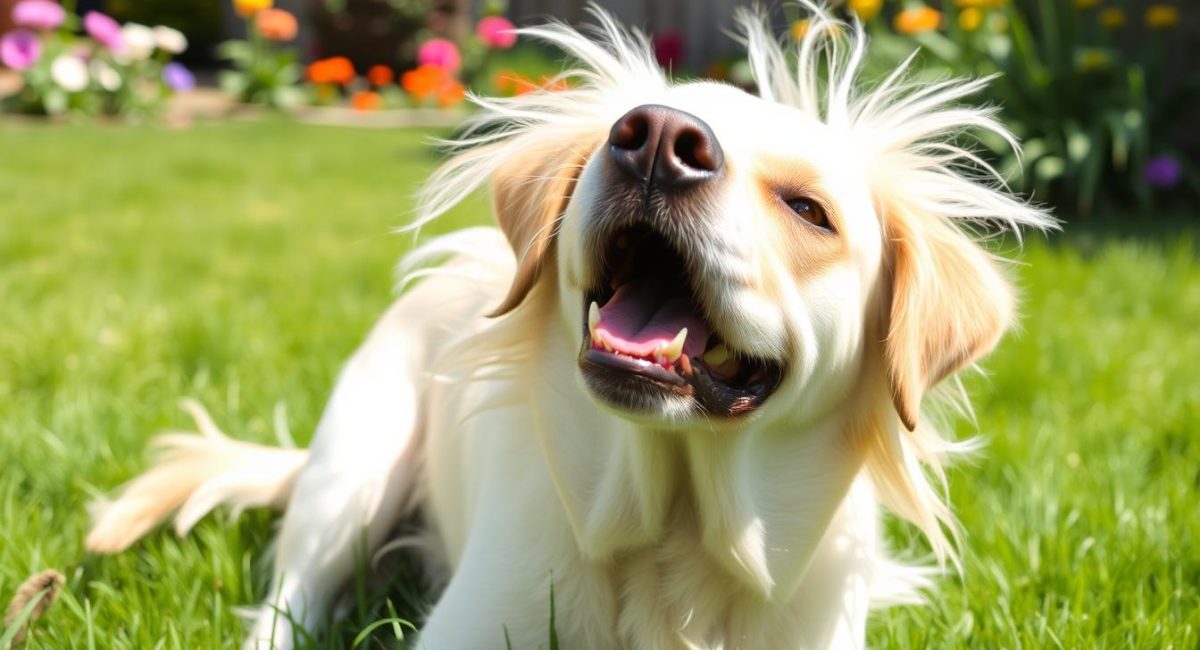Labrador Shedding: Do Labrador Retrievers shed a lot?
Did you know that Labrador Retrievers can shed up to twice a year in handfuls? They are among the breeds that shed the most1. Their double coat makes them famous for heavy shedding, especially in spring and fall1. It’s important for Labrador owners to understand why they shed so much and how to manage it to keep their homes hair-free.
Key Takeaways
- Labradors have a dense double coat that causes them to shed significantly throughout the year.
- Shedding is heaviest during the spring and autumn seasons when Labradors are changing their coats.
- Regular brushing and grooming, along with a balanced diet, can help manage excessive shedding in Labradors.
- Shedding is a normal and healthy process for Labradors, but excessive shedding may indicate an underlying health issue.
- Maintaining a consistent grooming routine and using the right tools can help reduce the amount of hair in your home.
Understanding Labrador Retrievers’ Double Coat
Labrador Retrievers have a unique double coat that’s key to their shedding patterns2. The outer layer is made of longer, coarser guard hairs. These protect them from the weather. The undercoat is dense and shorter, insulating their body2.
This coat helped Labradors in their role as water-retrieving dogs. It keeps them warm in cold waters and protects their skin.
Outer Coat: Protective Layer
The outer coat of a Labrador Retriever is made of longer, stiffer guard hairs3. These hairs are water-resistant. They keep the dog’s skin dry and protected from wind, rain, and snow3.
This coat is vital for Labradors to thrive in different climates and water activities.
Undercoat: Insulation and Warmth
The undercoat is dense and shorter, providing insulation and warmth3. It’s soft and downy, trapping heat close to the dog’s body. This keeps them warm even in cold conditions3.
The undercoat is crucial for Labradors to excel in water-based tasks and cold-weather environments.
The Labrador’s double coat is a key factor in their heavy shedding2. Both the outer and undercoat need regular grooming to manage shedding2. Knowing about their double coat helps manage shedding and keeps them healthy.
Seasonal Shedding Patterns
Labrador Retrievers, like many other dog breeds, shed in different ways throughout the year4. The main shedding times are spring and fall4. Double-coated breeds, such as Labradors, shed more noticeably4.
Spring: Heavy Shedding
In spring, Labradors shed their thick winter coat for the warmer summer4. This is called “coat blowing” and leads to a lot of hair loss4. Labrador Retrievers, Newfoundlands, and Pekingese shed a lot, while Dachshunds, Poodles, and Border Terriers shed less5.
Fall: Moderate Shedding
When autumn comes, Labradors shed their summer coat for a thicker winter one. This results in moderate shedding in the fall4. Golden Retrievers shed more all year because of their thick double-coat5.
Knowing when Labradors shed helps owners manage their coat changes better6.
“Seasonal shedding in dogs is most noticeable in the spring and autumn, with shedding occurring to prepare for warmer or colder weather.”5
Regular brushing, combing, and using shedding control shampoos and baths help manage shedding5. Problems like hypothyroidism or congenital issues can also cause too much shedding5.
Do Labrador Retrievers shed a lot?
Labrador Retrievers are famous for shedding a lot. They have a double coat that makes them one of the top shedding breeds7. This coat sheds a lot all year, but especially in spring and autumn7.
Labradors shed more in spring and fall when they change coats7. This can make your home very hairy. So, it’s key to manage their shedding well7.
Things like age, health, diet, and weather can affect how much a Labrador sheds7. Keeping them well-groomed, fed well, and using supplements can help7.
Labrador owners need to be ready for the hair these dogs shed. They should find ways to keep their homes clean and comfy7.
| Breed | Shedding Level | Coat Type |
|---|---|---|
| Labrador Retriever | Heavy | Double Coat |
| Poodle | Low | Single Coat |
| Soft-Coated Wheaten Terrier | Low | Single Coat |
| Portuguese Water Dog | Low | Single Coat |
| Schnauzer | Low | Double Coat |
The table shows Labradors shed a lot compared to other breeds8. Their double coat is the main reason for their heavy shedding8.
Even though Labradors shed a lot, you can manage it with the right grooming, diet, and supplements7. With the right care, you can keep your home clean and enjoy your Labrador’s company7.
Factors Affecting Shedding
Labrador Retrievers are known for their heavy shedding. But, several factors can change how much and how often they shed9. Age and health are big factors. Older Labradors might shed more or less, depending on their health.
Skin problems, allergies, and other health issues can also make them shed more9.
Diet and nutrition are also key9. A good diet with all the right nutrients helps keep their coat healthy and reduces shedding10. If they don’t get enough protein, omega-3 fatty acids, or other important vitamins and minerals, they might shed more10.
Age and Health
- Older Labradors may shed more or less than younger dogs, depending on their overall health9.
- Skin conditions, allergies, and other health issues can contribute to excessive shedding9.
Diet and Nutrition
- A balanced diet rich in essential nutrients, such as protein and omega-3 fatty acids, can help maintain a healthy coat and reduce shedding910.
- Deficiencies in certain nutrients can lead to increased shedding10.
- Drinking enough water is also important. Dehydration can make their skin dry and cause more shedding11.
Knowing what affects Labrador shedding helps owners take care of their dog’s coat. This way, they can keep their home cleaner91011.
“Proper nutrition and regular grooming are key to managing Labrador shedding.”
Managing Labrador Shedding
Managing Labrador shedding needs a few steps. Regular grooming and a good diet are crucial12. Labradors have a double coat, with long guard hairs and a dense undercoat12. This coat leads to heavy shedding, especially during seasonal changes.
Regular Grooming
Brushing often and using de-shedding tools helps13. Bathing regularly also keeps fur down13. Labs shed twice a year, and indoor Labs need baths every four to six weeks13.
Tools like the Furminator are great for removing dead hair14. Grooming at a parlour, like a “DE SHED”, costs about £2514.
Diet and Supplements
A good diet and supplements can help12. Omega-3 fatty acids, biotin, and zinc support a healthy coat12. This can reduce shedding12.
Combining these methods can keep your home fur-free14. Some owners find Labs leave a lot of fur around, needing constant cleaning14.
Keeping Your Home Hair-Free
Labrador Retrievers shed a lot, so keeping your home clean is key15. Vacuuming regularly is essential to get rid of dog hair on carpets and furniture16. Tools like lint brushes and rubber gloves can also help catch and hold the hair16.
Washing your dog’s bedding and blankets often can stop hair from spreading16. Giving your Labrador a special place to sleep helps keep the shedding in one area16. Regularly mopping and dusting also keeps your home hair-free, making it a comfortable place to be16.
Using covers or blankets on furniture can protect it from hair16. These can be taken off and washed, stopping hair from building up16. With these steps, along with good grooming and diet, you can keep your home clean from dog hair15161.
| Shedding Management Techniques | Benefits |
|---|---|
| Regular Vacuuming | Removes accumulated dog hair from carpets, furniture, and surfaces |
| Frequent Washing of Dog Bedding | Helps contain shedding to designated areas |
| Use of Furniture Covers/Blankets | Protects upholstery and makes cleaning easier |
| Mopping and Dusting | Maintains a hair-free environment on hard surfaces |
| Pet Hair Removal Tools | Efficiently capture and contain shedding |

By taking these steps, you can manage your Labrador’s shedding and keep your home clean15161.
Grooming Tools for Effective Shedding Control
Labrador Retrievers have thick, double-layered coats that shed a lot all year17. To keep their coats healthy and shiny, owners need the right grooming tools17.
The FURminator is a top choice for de-shedding Labradors. It’s made to remove loose undercoat hair without harming the outer coat17. Using it regularly can cut down on Labrador shedding, making it a key part of grooming.
Slicker brushes and grooming gloves are also great for Labradors. They spread the dog’s natural oils and get rid of loose hairs18. Used regularly, they help control shedding and keep the coat looking good.
Labradors shouldn’t have their coats clipped or trimmed18. This can mess up the coat’s natural insulation and stop it from working right. Instead, regular brushing and special de-shedding tools are best for managing shedding and keeping the coat healthy.
Getting the right grooming tools and sticking to a grooming routine can help manage Labrador shedding17. This way, owners can enjoy their furry friends while keeping their homes tidy.
Seeking Veterinary Advice
If your Labrador is shedding too much, it’s wise to talk to a vet19. Too much hair loss can mean health problems like allergies or skin infections19. A vet can check your dog, run tests, and suggest treatments to fix the issue19.
Labradors shed a lot because of their thick coats19. But, if the shedding is more than usual, a vet visit is needed19. They can find out why your dog is losing so much hair and help fix it.
Seeing a vet regularly is also good for your dog’s health20. Labradors live for about 10-12 years20. Keeping them healthy helps manage their shedding and improves their life.
- Veterinary examination can help identify underlying causes of excessive shedding, such as allergies, hormonal imbalances, or skin infections.
- Veterinary treatment may include medications, dietary changes, or other interventions to address the root cause of excessive shedding.
- Regular check-ups with a vet can help monitor a Labrador’s overall health and catch any issues early, including those related to their skin and coat.

By working with a vet, you can understand and manage your Labrador’s shedding1920. This ensures your dog stays healthy and happy.
Conclusion
Labrador Retrievers are known for their heavy shedding, which can be tough for owners21. But, with the right steps in Labrador shedding management, Labrador coat care, and keeping dog hair under control, the problem can lessen21. Regular brushing, using special tools, a healthy diet, and a clean home can cut down on Labrador hair around the house21.
Knowing why Labradors shed and following a good Labrador grooming routine helps owners enjoy their pets without hair everywhere21. Labradors have a double coat, with long guard hairs and a dense undercoat21. They shed a lot in spring and less in autumn, but they shed all year21. Things like age, health, diet, and where they live can affect how much they shed21.
By focusing on regular grooming, a balanced diet, and a clean home, Labrador owners can manage shedding21. This way, they can still love and enjoy their loyal and loving pets21. With the right strategy, owning a Labrador can be a joy without too much fur22.
FAQ
Do Labrador Retrievers shed a lot?
Yes, Labrador Retrievers shed a lot. Their double coat, with an outer layer and a dense undercoat, causes a lot of shedding. This happens all year round, especially in the spring and autumn.
What is the structure of a Labrador’s coat?
Labradors have a double coat. The outer layer is longer and coarser, protecting them from the weather. The undercoat is dense and short, keeping them warm. This coat helps them in their role as water-retrieving dogs.
When do Labradors experience the heaviest shedding?
Labradors shed the most in spring and autumn. In spring, they shed their thick winter coat for the warmer months. Autumn brings a thicker winter coat, leading to moderate shedding.
What factors can impact a Labrador’s shedding?
Several factors affect a Labrador’s shedding. Age, health, and diet play a big role. Skin conditions and allergies can also cause more shedding. A good diet is key to a healthy coat.
How can Labrador owners manage shedding?
Managing Labrador shedding involves grooming and diet. Regular brushing and baths help remove loose hair. A balanced diet and supplements can also help keep their coat healthy.
What other steps can Labrador owners take to keep their homes hair-free?
Owners can also use vacuuming and furniture covers to keep homes clean. Washing dog bedding often helps too. These steps help manage the amount of hair around the house.
What are the best grooming tools for managing Labrador shedding?
The right tools are essential for managing Labrador shedding. Tools like the FURminator remove undercoat hair without harming the topcoat. Slicker brushes and grooming gloves help with regular brushing and oil distribution.
When should Labrador owners seek veterinary advice?
If a Labrador sheds too much, it’s time to see a vet. Excessive shedding can signal health issues like allergies or skin infections. A vet can diagnose and treat these problems.
Source Links
- How To Reduce Shedding In Labs (5 Methods & Questions Answered) – https://www.snowypineswhitelabs.com/blog/how-to-reduce-shedding-in-labs/
- Labrador Retriever Breed Guide: Characteristics, History & Care – https://www.pawlicy.com/blog/labrador-retriever-dog-breed/
- What to Know About Labrador Retrievers – https://www.webmd.com/pets/dogs/what-to-know-about-labrador-retriever
- All Bay Animal Hospital – https://www.allbayanimalhospital.com/site/blog/2024/07/15/stop-dog-excessively-shedding
- No title found – https://www.akc.org/expert-advice/health/dog-shedding-what-to-expect-and-how-to-manage-it/
- How much hair should my dog be shedding? – https://www.petplan.co.uk/pet-information/dog/advice/how-much-hair-should-my-dog-be-shedding/
- Do Labrador Retrievers Shed a Lot | Dog Shedding Guide – https://inselife.com/blogs/articles/do-labs-shed?srsltid=AfmBOoqj__tYOY7upGeQ-eMhcamSrJzs0cLWbWYJ48wmrwIljzwSzTj1
- Do Labs Shed? What to Expect From America’s Favorite Dog – https://nativepet.com/blogs/health/do-labs-shed?srsltid=AfmBOorbeIgA8YcaxM6Mk_nldVBwMcgxRpAMU6yL0cxij2d1LwW2BXPb
- Do Labrador Retrievers Shed a Lot | Dog Shedding Guide – https://inselife.com/blogs/articles/do-labs-shed?srsltid=AfmBOorUB41iO0kU8UR7ZlpBfTN1n7UMzcBQE0p-xobN0n3WVbAkP_pz
- Do Labradors Shed? | How to Reduce Shedding | Moose & Mary – https://mooseandmarylabs.com/blog/do-labradors-shed/
- How Much Do Labradors Shed? Care and Grooming Tips – Dogster – https://www.dogster.com/lifestyle/how-much-do-labradors-shed
- Do Labrador Retrievers Shed a Lot | Dog Shedding Guide – https://inselife.com/blogs/articles/do-labs-shed?srsltid=AfmBOoo8I6-6y-Uf4vkVeb-1vpHBefEx-AjMmYcKgrlRHny3mMhypQXe
- No title found – https://www.akc.org/expert-advice/health/how-to-groom-a-labrador-retriever/
- Shedding is becoming a nightmare – https://www.labradorforums.co.uk/threads/shedding-is-becoming-a-nightmare.122785/
- 8 Proven Tips to Control Dog Shedding: Keep Your Home Fur-Free | Petmate – https://www.petmate.com/blogs/petmate-academy/8-tips-to-control-dog-shedding?srsltid=AfmBOoqKt1vqpslOv0IltI0hcKrMcK_FzHjNFBNwkoekEJBEG5xeJPEo
- Everything Dog Hair, How to Manage Shedding — Golden Retriever Life – https://www.goldenretrieverlife.com/blog/manage-shedding
- Do Labrador Retrievers Shed a Lot | Dog Shedding Guide – https://inselife.com/blogs/articles/do-labs-shed?srsltid=AfmBOoogXKy_8mSuMlcv92nW6m-ujdjpgdNKmlzpbrfUrTNziOUmZmGP
- How To Groom A Labrador – https://www.groomers-online.com/how-to-groom-a-labrador-retriever-i257
- Labrador: Temperament, Lifespan, Grooming, Training – https://www.petplan.co.uk/pet-information/dog/breed/labrador/
- Labrador Retriever Dog Breed Guide | Gundog Journal – https://gundog-journal.com/breeds/labrador-retriever
- Do Labrador Retrievers Shed a Lot | Dog Shedding Guide – https://inselife.com/blogs/articles/do-labs-shed?srsltid=AfmBOoqtxR8iMZ08eO-LEDF1_HHKDjP1awo-7J4rIy2bKrc2LZpdc8Xs
- Everything You Ever Wanted To Know About Labradors – Your Pet Nutrition – https://blog.yourpetnutrition.com/everything-you-ever-wanted-to-know-about-labradors/

